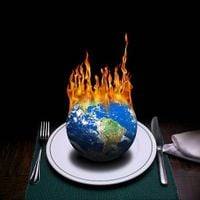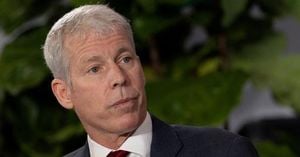Nature has always held a certain terror for humanity, lurking in the shadows of forests, swelling in the depths of oceans, and sometimes, as recent literature and scientific reports suggest, rising up in direct response to our own actions. In October 2025, a wave of eco-horror fiction and a sobering scientific report have converged to remind us: the environment is not just a backdrop to our lives, but a force that can—and perhaps will—fight back.
Eco-horror, a genre that explores the dread and consequences of environmental collapse, has surged in popularity, with recent anthologies and novels delving into the many ways nature’s wrath might manifest. At the same time, the EAT-Lancet Commission’s second report (EAT 2.0) underscores the real-world dangers of humanity’s impact on the planet, especially through our food systems. The collision of these two narratives—fictional and factual—offers a chilling reflection of our times.
According to Counterpunch, the EAT-Lancet Commission’s latest findings are stark: food systems account for about a third of global greenhouse gas emissions, with animal farming being a particularly large contributor due to methane production and the immense drain on land and water resources. Even more alarming, the report notes, is that "even if the world transitions away from fossil fuels, food alone could push temperatures past the 1.5°C threshold needed to limit warming." The burden is not evenly shared; the richest 30% of the world’s population are responsible for more than 70% of food-related environmental pressures, as reported by Bloomberg/Green.
Meanwhile, eco-horror fiction is tapping into these anxieties with visceral power. In Field Notes from a Nightmare: An Anthology of Ecological Horror, edited by Alex Ebenstein, eighteen stories explore climate catastrophe and the breakdown of our environment. Some tales employ dark humor, others go for outright terror, but all confront the consequences—sometimes fatal—of humanity’s interference with nature. From the simple act of touching a fuzzy caterpillar to the broader devastation wrought by climate change, these stories serve as both entertainment and warning.
Other recent works deepen the genre’s impact. Silvia Moreno-Garcia’s Mexican Gothic weaves a tale of a crumbling mansion where mold and mushrooms creep across the walls, symbolizing the insidious spread of racism and eugenic ideology. Hye-Young Pyun’s The Hole, translated by Sora Kim-Russell, uses a garden as the nexus of isolation and buried secrets, while Jeff Vandermeer’s Annihilation plunges readers into Area X, a reclaimed natural zone where the environment itself becomes a lethal adversary.
Trang Thanh Tran’s They Bloom at Night brings eco-horror into the aftermath of a hurricane in Mercy, Louisiana. Here, a red algae bloom grows in flooded streets, and something monstrous is rumored to lurk beneath the water. Tran’s story is not just about environmental dread, but also about trauma and gender identity, blending personal and planetary crises.
Kay Chronister’s The Bog Wife draws on centuries-old folklore, with a family whose survival depends on a cranberry bog and a supernatural pact. When the bog fails to deliver its expected “wife,” the family is thrown into turmoil, forced to confront their own secrets and the unpredictable power of the land they depend on. In Chlorophobia: An Eco-Horror Anthology, edited by A.R. Ward, 37 short stories and poems tackle nature’s revenge head-on, featuring everything from dying bees to invasive species and farm-to-table food gone awry. The anthology’s flash fiction format makes for quick, punchy reads, but the cumulative effect is a growing sense of dread—nature, it seems, is keeping score.
Samanta Schweblin’s Fever Dream, translated by Ruth Sepp, is a modern classic of eco-horror and social commentary. The novel follows Amanda, a woman lying dying as a mysterious boy tries to unravel the story of her poisoning. Pollution, poison, and grief intertwine in a narrative that is as much about a mother’s desperate love as it is about the real-life terrors of environmental contamination.
While fiction imagines the worst-case scenarios, the EAT-Lancet Commission’s report insists that we are already living in a dangerous reality. Global sea surface temperatures hit a record 20°C in August 2025, according to the ERSST database, which tracks data back to 1854. Major ecosystems—Greenland, the Arctic, Tibetan glaciers, and the Amazon rainforest—have been vastly altered by human activity, pushing nature into a precarious and potentially hostile imbalance.
The Commission’s prescription, as Counterpunch details, is the “planetary health diet.” This diet isn’t radical; it allows for moderate animal protein—one dairy serving and one other animal protein daily—while aiming to cut agricultural greenhouse gas emissions by 15%. Yet, despite its flexibility, the diet faces strong opposition, especially from those aligned with right-wing political movements. Global meat consumption continues to rise, and alternative proteins are losing popularity, leaving the EAT-Lancet recommendations fighting an uphill battle.
“Our entire infrastructure & civilization are based around climate that no longer exists,” says John Marsham, Professor of Atmospheric Science at the University of Leeds, as quoted in Counterpunch. The cost of righting the ship is daunting: achieving Net Zero by 2050 through renewable energy would require $7 trillion per year, yet only $2 trillion was invested in 2024. The shortfall is staggering, and with global priorities divided—armed conflict at its highest since World War II, according to the Peace Research Institute Oslo—the prospect of a unified, all-in commitment seems distant.
Eco-horror fiction and scientific reality are, in their own ways, telling the same story: nature is no longer a passive stage for human drama. It is a powerful, sometimes vengeful force, and our actions have consequences that are becoming impossible to ignore. Whether through the creeping dread of mold and mushrooms in a haunted mansion or the hard data of climate tipping points and emissions, the message is clear. The world stands at a crossroads—one path leads to adaptation and mitigation, the other to chaos and collapse.
As stories of sharp vines, microplastics, and monstrous blooms accumulate on the page and in the headlines, the sense of urgency grows. Nature, it seems, is writing its own horror story—and we are both the authors and the protagonists.




